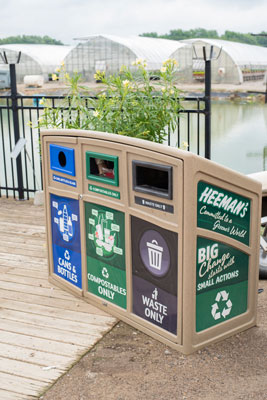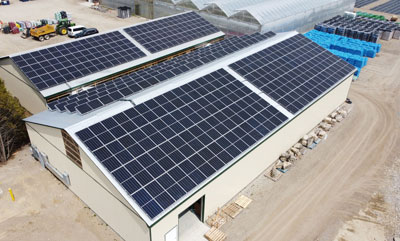11/1/2022
What Sustains Sustainability?
Bill McCurry

Is sustainability the financially right thing to do? Not always,” admits Will Heeman of Heeman’s Greenhouses outside London, Ontario, Canada. Sustainability is desired, yet not always straightforward. Politicians and special interests sometimes overstate the potential and understate the realities. That doesn’t make sustainability undesirable. But it does require awareness of the issues and commitment to the greater good.
“The dollar payback from large sustainability investments is too uncertain and/or too long to materialize in order to rationalize these investments solely on an economic basis for our operations,” Will continues. “Yes, ROI (return on investment) must be considered, but ROE (return on environment) must also be considered as a responsible community member.”
Financial reality requires measured decision-making so the company itself is sustainable. Bankrupt organizations can’t support any effort, no matter how well-meaning it might be. Many sustainability efforts (water, fertilizer, packaging, energy conservation) are easy sustainable investments with economic payback.
“We discuss our sustainability efforts at our regular family meetings because we want this business to be sustainable for future generations to operate. Looking at our goal to be ‘green and growing’ is a lens we judge our actions with,” he says. “Either we can be part of making our community successful and healthy tomorrow or we can sit back and do nothing but hope. We know hope is not a strategy. We know small actions can lead to big changes.”
Heeman’s has long been a social media powerhouse. By gently releasing sustainability endeavors on social media, they have garnered piles of positive responses from their loyal customers, enticing other social media participants to visit and support Heeman’s.
Greenwashing means distorting sustainability efforts to make customers erroneously feel better about patronizing the business. “Compostable” materials don’t mean they instantly dissolve in the landfill. It means the single-use cutlery, dishes and containers in Heeman’s Beanery (café) must be shredded, heated and treated to eventually become organic matter or compost. Heeman’s pays a local commercial composting facility for weekly pickup and processing.
Heeman’s installed field drip irrigation and ebb-and-flow tables in the greenhouse decades ago (they were green before it was cool, trendy or popular). To educate and inform their customers on what this meant and why it mattered, Heeman’s produced explanatory videos for social media showing the world how they were reducing water consumption by 80% while also reducing fertilizer usage.
Heeman’s prioritizes the environment and was awarded 2019’s Business Achievement Award by the London (Ontario) Chamber of Commerce. That year they also became a founding member of Green Economy London, a regional environmental organization connecting businesses committed to a green economy and reaching Canada’s pledge to be carbon neutral by 2050.
Heeman’s employees wear orange shirts to identify themselves to customers. Will Heeman says, “Who you don’t see are the millions of good bugs working for us to get rid of the harmful bugs.” The greenhouse also sells beneficial insects. When the supply of local praying mantis was exhausted, Heeman’s went public with their decision not to follow the trend of importing the insects from China. They told their customers they didn’t want to introduce a foreign species without knowing the impact it could have on the domestic insects.
Traditionally, it’s believed if you have excess solar power you can sell it back to the local utility. That is true in the inner city where there is minimal space for solar cells. Regulations in Ontario prohibited Heeman’s from installing as large a system as initially planned due to grid limitations on their rural road. Currently, due to the rural limitations, only about 54% of their electrical usage can be handled by solar. The investment has a break-even of 16.39 years (after grant funding). This could improve if electricity costs rise under the Canadian government’s carbon tax program. Heeman’s did qualify for government grants that covered approximately 25% of the installation costs.
 Their addition of solar-powered Electric Vehicle (EV) charging stations generated support from current EV owners and lots of questions from future EV owners. EV-owning customers said they would extend their stay at Heeman’s so they could get a full charge. EV users can’t go into a charging station and say “fill it up” like gas-powered vehicles because charging takes time. EV users are constantly “topping off” their charge so they’ll always have as much power available as possible.
Their addition of solar-powered Electric Vehicle (EV) charging stations generated support from current EV owners and lots of questions from future EV owners. EV-owning customers said they would extend their stay at Heeman’s so they could get a full charge. EV users can’t go into a charging station and say “fill it up” like gas-powered vehicles because charging takes time. EV users are constantly “topping off” their charge so they’ll always have as much power available as possible.
Heeman’s charges $1.80 per hour of charging (3¢ minute). The normal rate in Ontario is $2.40 per hour (4¢ minute). Heeman’s generates a very small margin (generation costs are around 2.5¢). Due to capital costs, maintenance and daily management costs this isn’t enough to make the chargers a profit center. In theory, if every station is full every minute the store is open, they won’t generate $100 a day. The cost to purchase and install three Level 2 EV chargers, capable of charging six cars at once, was $60,000 for Heeman’s. To incentivize EV charger installations the Canadian government offers grants to cover 50% of project costs.
The family acknowledges ROI as a critical business tool while balancing ROE as a requirement of being a good citizen. Future Ontario residents will thank Heeman’s for their present day commitments. GP
Bill would love to hear from you with questions, comments or ideas for future columns. Please contact him at wmccurry@mccurryassoc.com or (609) 731-8389.